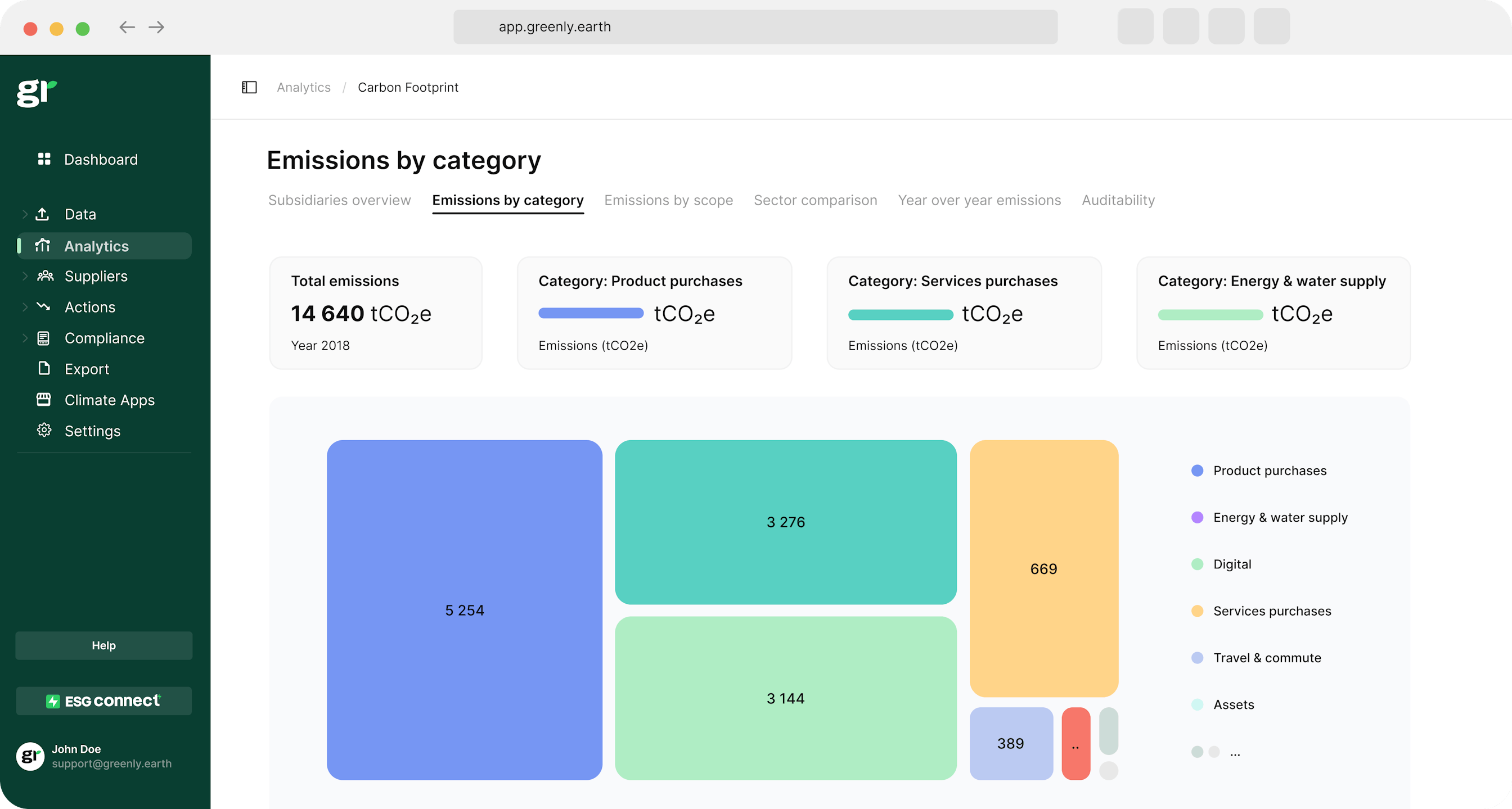ESG / CSR
Industries
New York vs. Paris – Which One is More Sustainable?



New York City vs. Paris: an age-old comparison between two of the world’s most alluring and well-known cities – with people often pointing out their similarities when in fact the two couldn’t be more different.
New York City is truly the city that never sleeps – tagged as the, “greatest city in the world” by many. However, many people who travel to New York will learn that what makes Times Square and the city’s bustling crowds so encapsulating isn’t the fact that New York City is pretty. It’s not pretty.
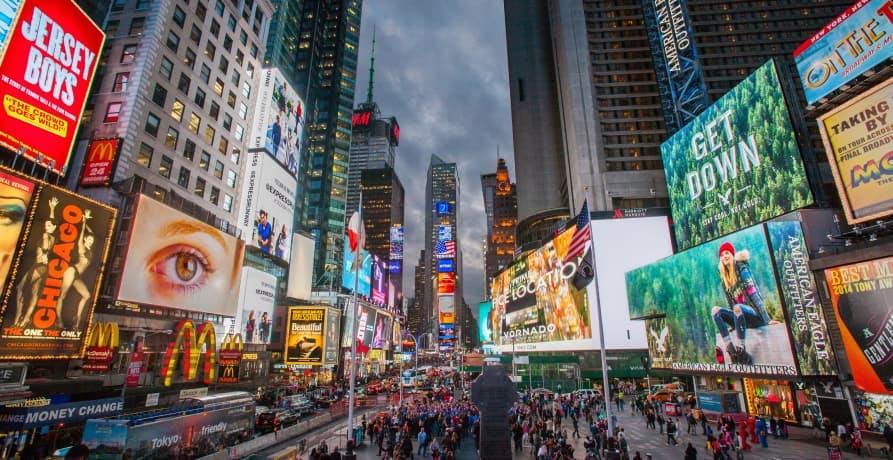
New York City is amazing. Flashing lights and busy streets force you to remind yourself that life moves forward no matter the circumstances, and to keep pushing forward. On the other hand, Paris operates on an antithetical type of charm – with every street covered in historical beauty and small side streets to accidentally wander down and marvel in.
Even if you’re lost in Paris, you won’t mind it too much – because there is something exquisite to look at every corner you turn. Paris depicts the beauty in getting lost: reminding you that it’s more about the journey than the destination.

New York vs. Paris: two cities illustrating the value in sense and sensibility respectively, but there’s another comparison that hasn’t been made yet – and that’s which city is more sustainable to live in.
In this article, we’ll talk about the nature of New York vs. Paris, which city has been more successful in implementing sustainable tactics than the other, and which city is overall the more sustainable place to live.
What are some of the differences between New York vs. Paris?
New York vs. Paris has been a time-old comparison, but many people don’t realize that comparing New York vs. Paris is a lot like comparing apples to oranges.
Paris vs. New York: From Metro and Pizza Rats to Notre Dame de Paris
These two cities have entirely different cultures between French culture with very cheap wine, work life balance, and French people as a whole, New York's metro and pizza rats, topographies, city limits and language and immigration status, and vastly different historical landmarks such as the Statue of Liberty and Notre Dame de Paris located in central Paris of the infamous capital city centre.
Let’s break down some of the differences between New York vs. Paris:
City Size & Population
When counting all five boroughs of New York City – New York is much larger than Paris is when it comes to both land area and population. New York in terms of land area and population. As of 2022, New York City has a population of 8.3 million and the population of Paris tops in at 2.1 million people in the famous Île de la Cité or Île de France region.
Aesthetics & Architecture:
While both Paris and New York have historical context and old neighborhoods, New York is ultimately a much more modern city in comparison to the preserved nature of Paris.
👉 Did you know? Paris implemented a height limit for buildings (besides Tour Montparnasse) so that massive skyscrapers couldn’t over shadow the Eiffel Tower.
New York City has both modern skyscrapers and quintessential “fire escape” buildings depending on the neighborhood you’re in – whereas Paris on the other hand is more homogeneous throughout unless you make your way to some of the newer arrondissements (neighborhoods) like the 13th and the 15th.
People are likely to be able to name more iconic landmarks from Paris than they are from New York: such as the Eiffel Tower, Notre-Dame, Louvre, and the Arc de Triomphe. Lesser known landmarks in the French capital include the town hall, Palais de Justice and Bois de Vincennes. New York is known for some of its more modern additions such as the Empire State Building and One World Trade Center.
👉 Did you know? The Statue of Liberty was actually a gift from France – and there are 5 “miniature” replicas of the infamous statue to be found around Paris!

Average Price of Rent: New York & Paris Compare
New York city is known to be one of the most expensive places in the world to live, and with crazy people exposing themselves amongst Times Square all of the time – it can prove a tiring place not only energetically, but financially.
Generally, just renting a room in the East Village could run you $1,400 a month – while many can afford a one bedroom apartment in the world class city of Paris for this same amount. However, it can prove tricky to find an apartment in Paris – and it may be necessary to speak French whereas in New York City almost everyone (including your potential landlord) will speak English.
Culture & Cuisine:
Both New York and Paris have historical influences, but they are different. Parisians are more known to be history buffs: valuing education in classic arts, literature, philosophy, and historical traditions. New York is more known for its influence on pop culture and modern society: serving as a place for utmost financial and media literacy.
The lifestyles between New York and Paris couldn’t be more different. New Yorkers are known to always be on the go: with a bagel in one hand, coffee in the other, and juggling a phone call in between. Paris is known for its leisure: with Parisians often taking up to a two hour lunch break – something New Yorkers would be caught dead doing.
👉 New York City never goes to sleep – whereas Paris likes to take a breather to stop and smell the roses, drink a coffee, or listen to the birds.
Something both New York and Paris are known for is good food – with Paris being known for its French cuisines and gastronomic culture, and New York being known for having any type of cuisine in a matter of minutes.
However, despite the differences between the two cities – there are several similarities between New York City and Paris:
- Both Manhattan and Paris are densely populated and serve as business capitals for the U.S. and France respectively
- Both cities are known for their cuisine and multicultural populations
- Both New York and Paris have a lively art scene and offer unique opportunities for artists
- Both cities attract global attention and tourism
- Both New York and Paris are known to be fashion capitals of the world
- Both cities provide a vivacious and intriguing urban experience
New York City and Paris are some of the world’s most well-known cities for good reason, but how well-known are these cities when it comes to sustainability?
| Aspect | New York City | Paris |
|---|---|---|
| Location | United States, East Coast | France, Île-de-France region |
| Population | Approx. 8.4 million | Approx. 2.1 million |
| Language | English | French |
| Currency | US Dollar (USD) | Euro (EUR) |
| Iconic Landmarks | Statue of Liberty, Times Square, Central Park | Eiffel Tower, Louvre Museum, Notre-Dame Cathedral |
| Public Transport | Subway, buses, taxis | Metro, buses, trams |
| Climate | Humid subtropical | Oceanic |
| Famous for | Broadway, Wall Street, diverse culture | Fashion, art, cuisine |
| Nightlife | Vibrant, with numerous bars, clubs, and theaters | Chic, with stylish bars, clubs, and cabarets |
| City Layout | Grid system, skyscrapers | Historical architecture, boulevards |
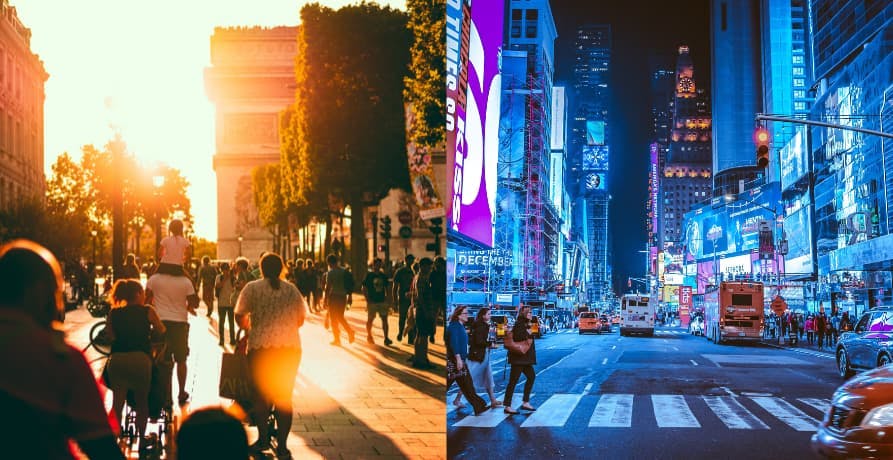
Let’s break down sustainability factors: New York vs. Paris
Shopping: Fifth Avenue vs. Champs Elysees
Both New York and Paris are renowned for their high-end shopping – but the two cities aren’t exactly up-to-speed with their sustainable efforts between Fifth Avenue and the Champs Elysees.
For starters, France banned plastic bags back in July 2016 – making Parisians a little more accustomed to taking their own bags with them when grocery shopping as opposed to New Yorkers, who often still forget to bring a reusable shopping bag when out and about.
However, New York has since banned plastic bags and even imposed a 5 cent fine for those who need a paper bag.
👉 Did you know? The Champs-Elysees is closed for pedestrians only at least one Sunday a month – a great way to stimulate both the economy to entice shoppers and also reduce greenhouse gas emissions.

Transportation: Subway vs. Metro
If there’s one way to irritate a New Yorker or Parisian right off the bat – and it’s to accidentally call the New York subway “the metro” or the Parisian metro “the subway”.
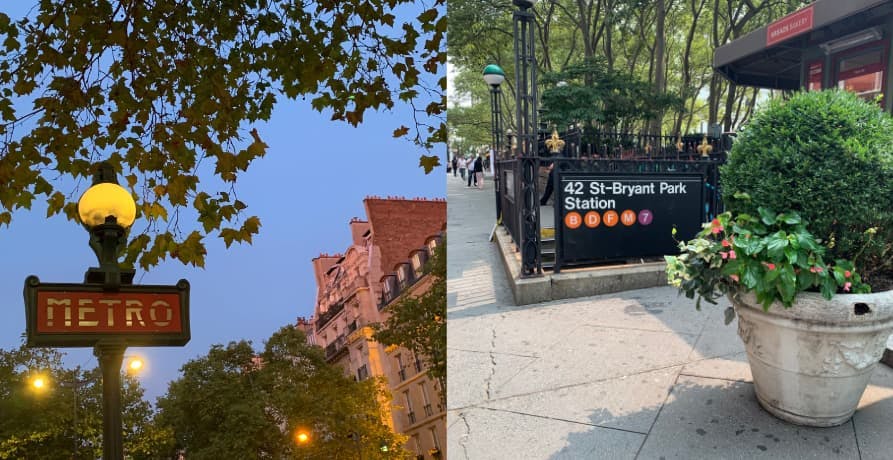
Both New York and Paris make use of rail transit systems, but ultimately – New York has a larger carbon footprint in transportation than Paris: with the transportation sector in New York accounting for 47% of overall emissions. The reason for this is that many New Yorkers and tourists alike will still make use of rideshares and iconic yellow taxi cabs in the city – with there still being more than 100,000 daily taxi cab rides in New York as of December 2021.
Whereas Paris, on the other hand, only 31% of emissions in France originate from transportation – with people opting to take an Uber or taxi much less common. Parisians are more likely to hop on a bus or ride-share bike than New Yorkers are: stemming from the cultural differences where New Yorkers are more in a rush to get to where they need to go, and won’t have the patience or time to bike through midtown.
However, both cities have implemented these ride-share bikes services: known as Vélib in Paris and as Citi Bike in New York City.
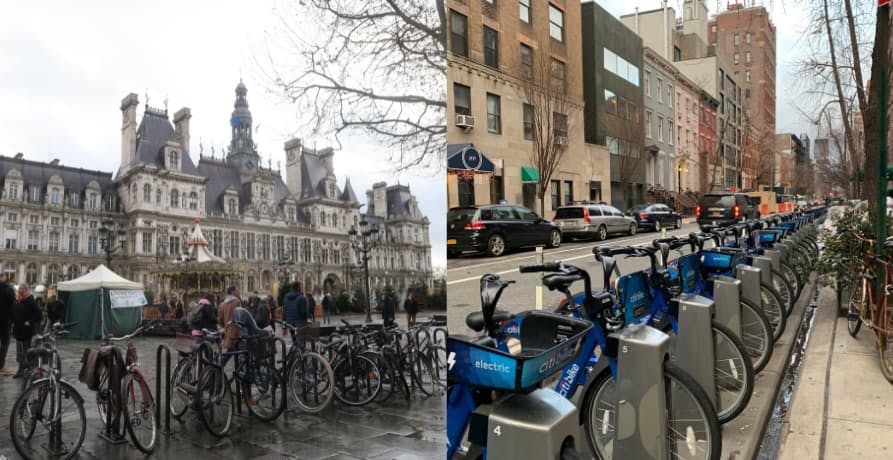
Food: Bagels vs. Baguettes
Both New York and Paris are known for their fine dining restaurants and food experiences – but that means both of these cities are prone to create a carbon footprint in this sector.
In New York, almost 4 million tonnes of food ends up in landfills, whereas Paris wastes around 60,000 tonnes of food each year.
However, reform is on the way – with New Yorkers soon being required to compost to prevent further food waste, and the same will be required for all French households starting in 2024.
It is worth nothing that while Paris is catching up to the plant-based craze, you are still much more likely to find vegan or plant-based milk options in New York City than you are in Paris – making New York the more sustainable choice here.
Another population comparison between New York vs. Paris is often the consumption of bagels vs. baguettes – but does one have a higher carbon footprint than the other?

The ingredients used in bagels and baguettes are mostly similar – but bagels require more time and could ultimately use more energy to make than baguettes do. This is because bagels require more kneading and mixing than baguettes do, and also have to be boiled prior to baking – meaning bagels require more water than baguettes.
Housing: New York Skyscrapers vs. Parisian Rooftops
Both New York and Paris are suffering from housing shortages, but New York may have the upper edge on Paris when it comes to sustainable housing.
This is because many buildings in New York are newer, meaning they are better insulated than Parisian apartments and won’t require as much continuous heating or air conditioning.
However, New York is known for its population density and heavy weight of its buildings – to the extent that electricity and heating in New York’s buildings make up a whopping 70% of New York’s climate pollution. Also, New Yorkers are much more likely to have air conditioning systems set up in their apartments as opposed to Parisians.
On this note, Parisian apartments may seem more energy efficient because they’re old – but think again. Paris has older buildings, which mean less sufficient insulation – meaning more heat is required to keep apartments warm during the winter. This ultimately results in greater energy consumption for those who live in Paris.
👉 Ultimately, the more modernized infrastructure in New York is likely to be more sustainable in the long-run over Parisian apartment buildings.
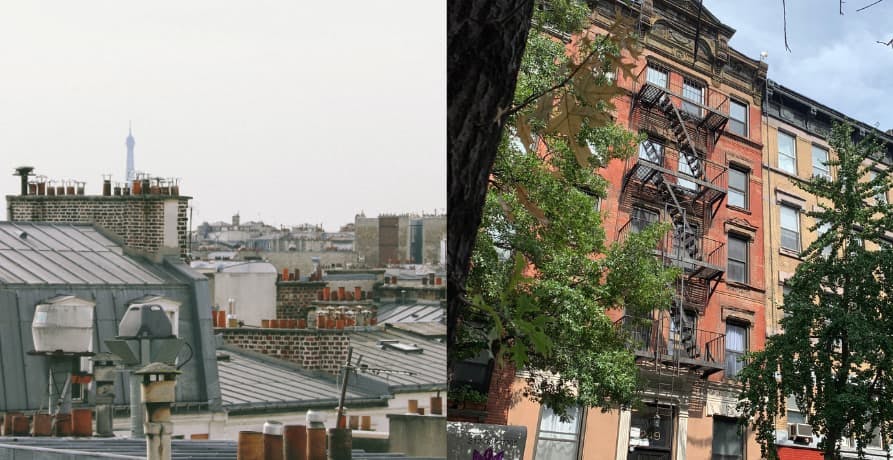
Travel: Road Trip vs. Train Rides
Americans are much more likely to take road trip than their Parisian counterparts, which evidently has a much higher carbon footprint than Parisians who will often opt to travel by TGV (high speed trains) across Europe.
The carbon footprint of a road trip from New York City to the Catskills (a common mountainous getaway for New Yorkers) is estimated to be around 144 pounds (or 65.5 kilograms) of carbon dioxide – with the drive being approximately 2 hours and 24 minutes and a total of 121 miles (around 194 kilometers) away, and would require around 7.4 gallons (or 28 liters) of gasoline round-trip.
On the other hand, the carbon footprint for a train ride from Paris to the south of France in Marseille is around 95 pounds.
💡 If you love to travel and want to be more sustainable, Paris is probably the better option over New York.

How has each city made an effort to reduce its emissions: New York vs. Paris?
New York Emission Reduction Efforts
New York has made copious efforts to reduce its environmental impact: such as by facilitating the transition to the use of clean energy and implementing energy-efficient technologies.
Most notably, New York has made an effort to reduce emissions from transportation by encouraging New Yorkers to opt for biking and electric cars whenever the subway isn’t viable. More examples of New York making an effort to be more sustainable include their Climate Action Scoping Plan, New York State Renewable Portfolio Standard, and New York’s upcoming Sustainable Fashion Laws.
Paris Emission Reduction Efforts
Paris has recently announced new urban planning that will encourage the city to be more respectful of the environment, renovate existing buildings, and build new low-carbon infrastructure. This urban planning, called the PLU, is meant to help propel the city towards more sustainable practices.
Some measures to be implemented include:
- Construction of social housing
- New green areas throughout Paris
- Make pharmacies, grocery stores, and general necessities all within a 15-minute walk of Parisian’s homes
💡 In addition to this, Paris has declared its commitment to help make the 2024 Paris Olympics more sustainable – such as by building an Athletes village for the Olympics to be used as green housing and offices afterwards.
Which city is ultimately more sustainable: New York or Paris?
Do we have a winner?
Ultimately, between transportation, food, and travel – New York creates a higher carbon footprint than Paris does. However, the old structure of Parisian buildings poses a threat for Paris trying to shift to the use of clean energy – something the modernized architecture in Manhattan isn’t as likely to struggle with.
👉 However, New York is ultimately home to more people and participates in a more consumption-valued society – making in harder to control sustainability factors as much of human activity is to blame for increased emissions.

The slower paced lifestyle in Paris where less is more is likely to result in an overall more sustainable lifestyle, but New York’s modern housing and innovative nature allows the opportunity for new sustainable features in the future.
In the end, there are pros and cons to sustainability in both cities – and deciding which one to live doesn’t mean your carbon footprint is inherently going to be higher. In fact, many of these differences are contingent on your own lifestyle and actions.
However, if we’re going to break it down by the numbers and factors discussed in this article – it appears that the more laid-back lifestyle of Paris adheres to more sustainable values and equates to a smaller carbon footprint than life in New York.
The time-old comparison between New York vs. Paris may always be of interest and never fully answered – but how we work together to combat climate change doesn’t need to be a question.
What about Greenly?
If reading this article about New York vs. Paris and which city is more sustainable and results in you producing a lower carbon footprint has made you interested in reducing your carbon emissions to further fight against climate change – Greenly can help you!
Breaking down the emissions between two cities like New York and Paris isn’t our only strong suit – click here to schedule a demo to see how Greenly can help you break down the carbon emissions within your own company.
Greenly can help you make an environmental change for the better, starting with a carbon footprint assessment to know how much carbon emissions your company produces.
